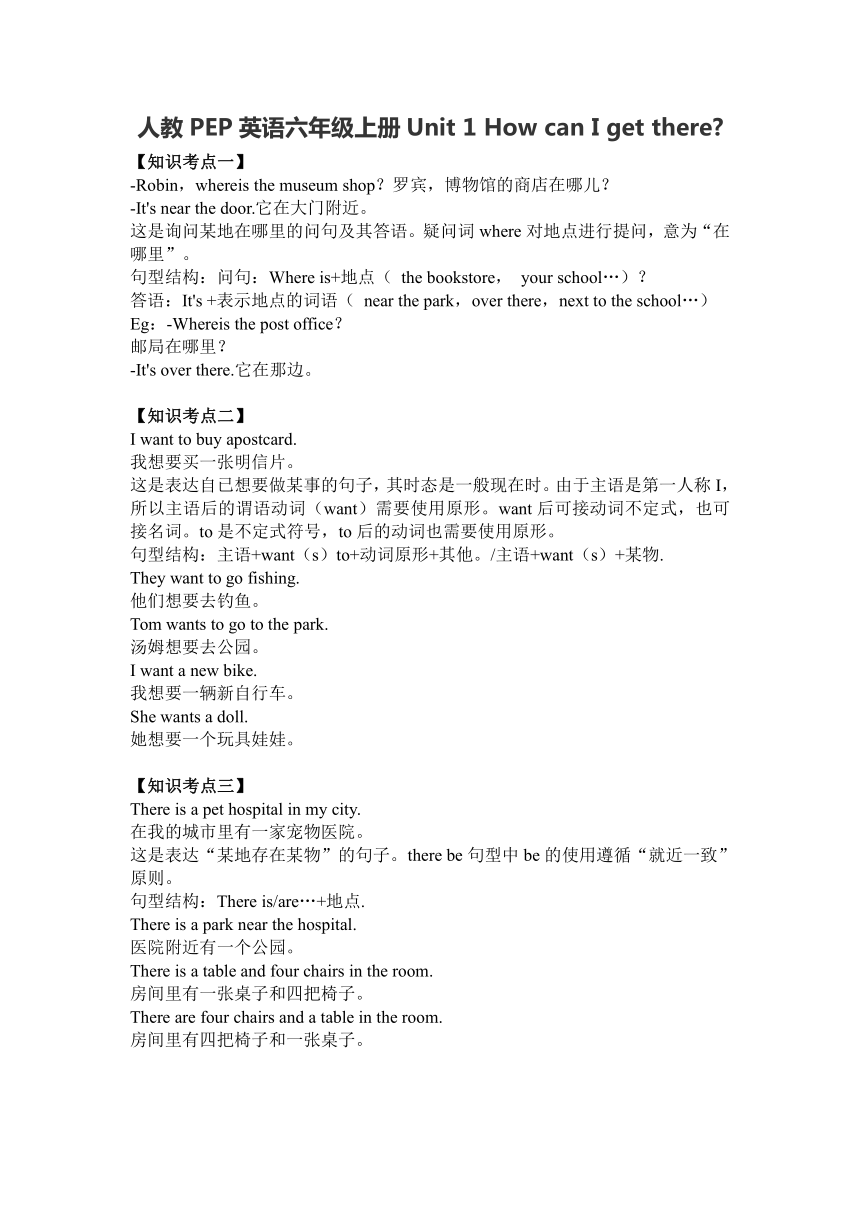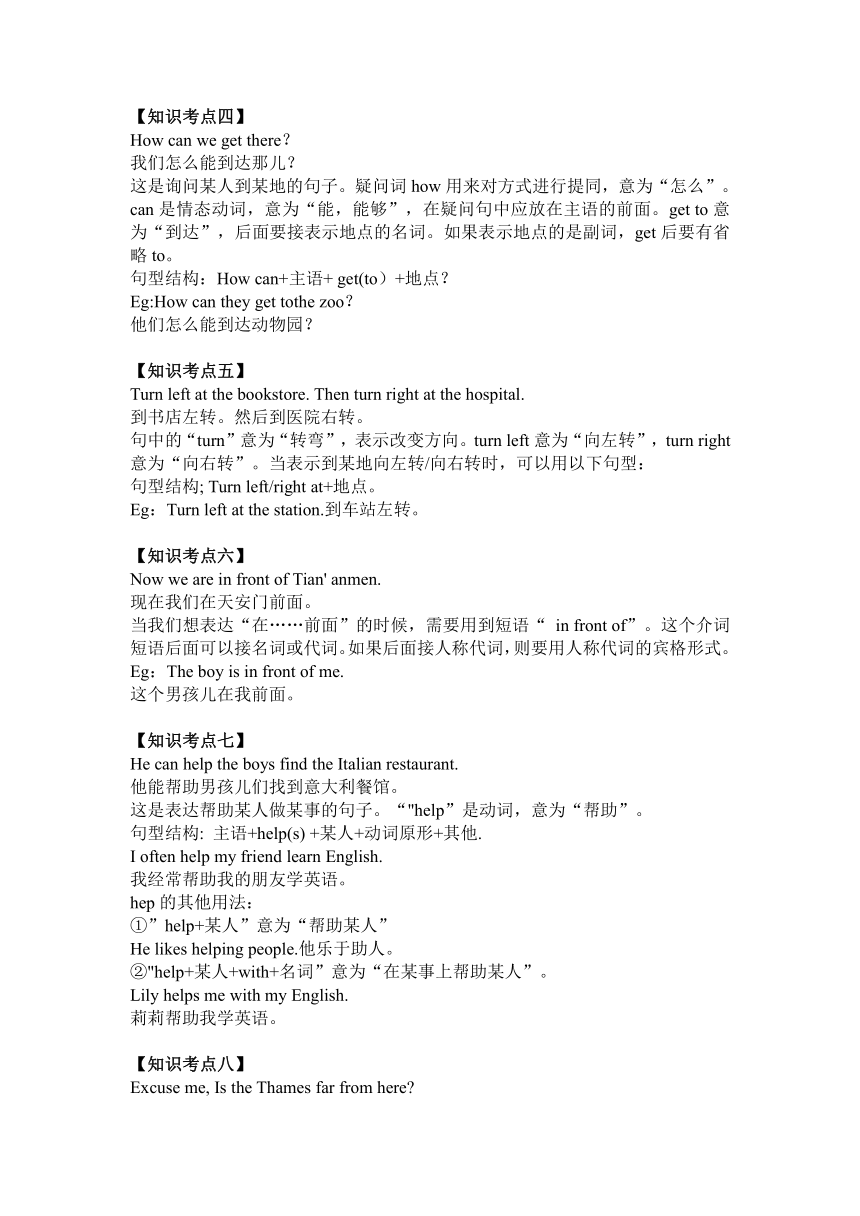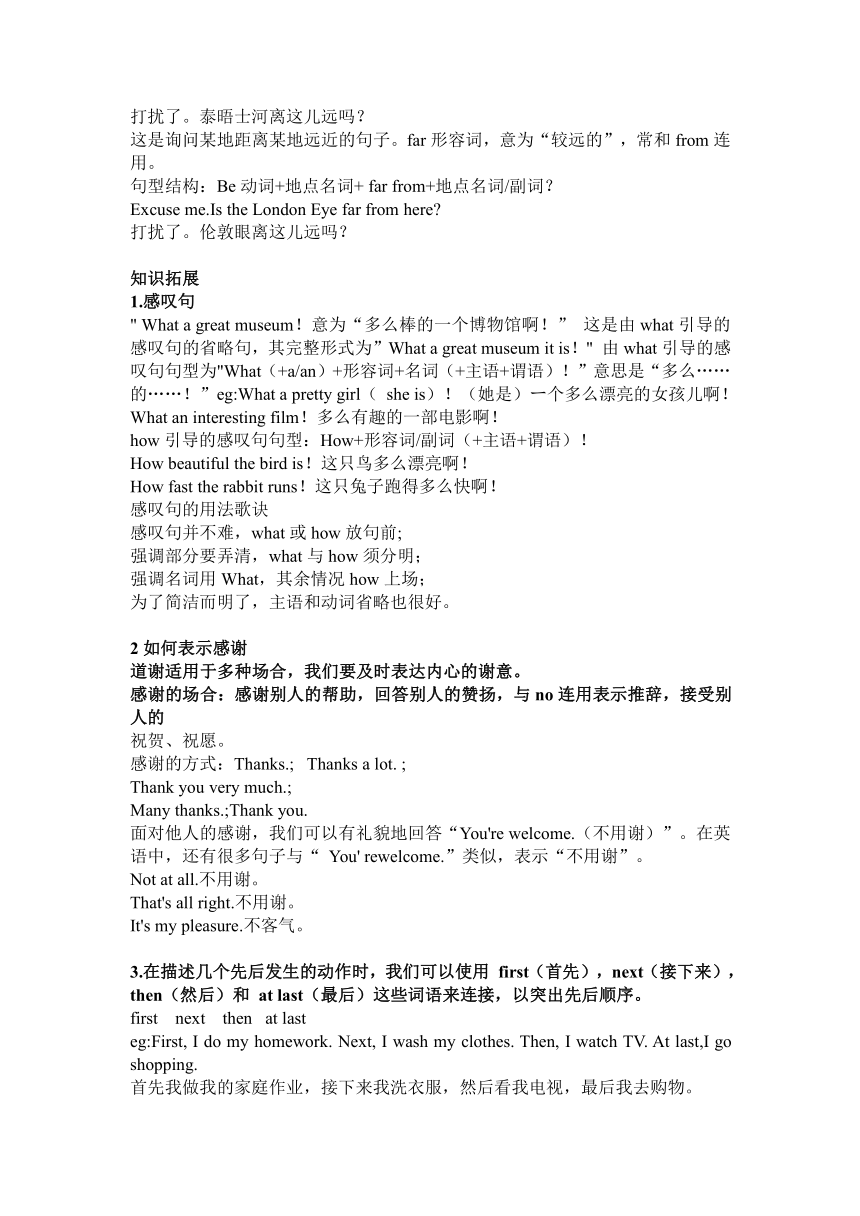Unit 1 How can I get there? 讲义
文档属性
| 名称 | Unit 1 How can I get there? 讲义 |  | |
| 格式 | docx | ||
| 文件大小 | 26.3KB | ||
| 资源类型 | 教案 | ||
| 版本资源 | 人教版(PEP) | ||
| 科目 | 英语 | ||
| 更新时间 | 2024-09-26 17:35:04 | ||
图片预览



文档简介
人教PEP英语六年级上册Unit 1 How can I get there
【知识考点一】
-Robin,whereis the museum shop?罗宾,博物馆的商店在哪儿?
-It's near the door.它在大门附近。
这是询问某地在哪里的问句及其答语。疑问词where对地点进行提问,意为“在哪里”。
句型结构:问句:Where is+地点( the bookstore, your school…)?
答语:It's +表示地点的词语( near the park,over there,next to the school…)
Eg:-Whereis the post office?
邮局在哪里?
-It's over there.它在那边。
【知识考点二】
I want to buy apostcard.
我想要买一张明信片。
这是表达自已想要做某事的句子,其时态是一般现在时。由于主语是第一人称I,所以主语后的谓语动词(want)需要使用原形。want后可接动词不定式,也可接名词。to是不定式符号,to后的动词也需要使用原形。
句型结构:主语+want(s)to+动词原形+其他。/主语+want(s)+某物.
They want to go fishing.
他们想要去钓鱼。
Tom wants to go to the park.
汤姆想要去公园。
I want a new bike.
我想要一辆新自行车。
She wants a doll.
她想要一个玩具娃娃。
【知识考点三】
There is a pet hospital in my city.
在我的城市里有一家宠物医院。
这是表达“某地存在某物”的句子。there be句型中be的使用遵循“就近一致”原则。
句型结构:There is/are…+地点.
There is a park near the hospital.
医院附近有一个公园。
There is a table and four chairs in the room.
房间里有一张桌子和四把椅子。
There are four chairs and a table in the room.
房间里有四把椅子和一张桌子。
【知识考点四】
How can we get there?
我们怎么能到达那儿?
这是询问某人到某地的句子。疑问词how用来对方式进行提同,意为“怎么”。can是情态动词,意为“能,能够”,在疑问句中应放在主语的前面。get to意为“到达”,后面要接表示地点的名词。如果表示地点的是副词,get后要有省略to。
句型结构:How can+主语+ get(to)+地点?
Eg:How can they get tothe zoo?
他们怎么能到达动物园?
【知识考点五】
Turn left at the bookstore. Then turn right at the hospital.
到书店左转。然后到医院右转。
句中的“turn”意为“转弯”,表示改变方向。turn left意为“向左转”,turn right意为“向右转”。当表示到某地向左转/向右转时,可以用以下句型:
句型结构; Turn left/right at+地点。
Eg:Turn left at the station.到车站左转。
【知识考点六】
Now we are in front of Tian' anmen.
现在我们在天安门前面。
当我们想表达“在……前面”的时候,需要用到短语“ in front of”。这个介词短语后面可以接名词或代词。如果后面接人称代词,则要用人称代词的宾格形式。
Eg:The boy is in front of me.
这个男孩儿在我前面。
【知识考点七】
He can help the boys find the Italian restaurant.
他能帮助男孩儿们找到意大利餐馆。
这是表达帮助某人做某事的句子。“"help”是动词,意为“帮助”。
句型结构: 主语+help(s) +某人+动词原形+其他.
I often help my friend learn English.
我经常帮助我的朋友学英语。
hep的其他用法:
①”help+某人”意为“帮助某人”
He likes helping people.他乐于助人。
②"help+某人+with+名词”意为“在某事上帮助某人”。
Lily helps me with my English.
莉莉帮助我学英语。
【知识考点八】
Excuse me, Is the Thames far from here
打扰了。泰晤士河离这儿远吗?
这是询问某地距离某地远近的句子。far形容词,意为“较远的”,常和from连用。
句型结构:Be动词+地点名词+ far from+地点名词/副词?
Excuse me.Is the London Eye far from here
打扰了。伦敦眼离这儿远吗?
知识拓展
1.感叹句
" What a great museum!意为“多么棒的一个博物馆啊!” 这是由what引导的感叹句的省略句,其完整形式为”What a great museum it is!" 由what引导的感叹句句型为"What(+a/an)+形容词+名词(+主语+谓语)!”意思是“多么……的……!”eg:What a pretty girl( she is)!(她是)ー个多么漂亮的女孩儿啊!
What an interesting film!多么有趣的一部电影啊!
how引导的感叹句句型:How+形容词/副词(+主语+谓语)!
How beautiful the bird is!这只鸟多么漂亮啊!
How fast the rabbit runs!这只兔子跑得多么快啊!
感叹句的用法歌诀
感叹句并不难,what或how放句前;
强调部分要弄清,what与how须分明;
强调名词用What,其余情况how上场;
为了简洁而明了,主语和动词省略也很好。
2如何表示感谢
道谢适用于多种场合,我们要及时表达内心的谢意。
感谢的场合:感谢别人的帮助,回答别人的赞扬,与no连用表示推辞,接受别人的
祝贺、祝愿。
感谢的方式:Thanks.; Thanks a lot. ;
Thank you very much.;
Many thanks.;Thank you.
面对他人的感谢,我们可以有礼貌地回答“You're welcome.(不用谢)”。在英语中,还有很多句子与“ You' rewelcome.”类似,表示“不用谢”。
Not at all.不用谢。
That's all right.不用谢。
It's my pleasure.不客气。
3.在描述几个先后发生的动作时,我们可以使用 first(首先),next(接下来),then(然后)和 at last(最后)这些词语来连接,以突出先后顺序。
first next then at last
eg:First, I do my homework. Next, I wash my clothes. Then, I watch TV. At last,I go shopping.
首先我做我的家庭作业,接下来我洗衣服,然后看我电视,最后我去购物。
4.什么是主语?
主语是谓语的陈述对象,指出谓语说的是谁或者是什么的句子成分
5.什么是情态动词?
情态词是本身有一定的词义,表示说话人的情绪、态度或语气的动词。情态动不能独作谓语,只能与动词原形一起构成谓语。情态动词有shall, should,will,would, can, could,may,might,must,need等。
in the front of只比 in front of多了一个定冠词“the",但两者的含义却大不相同:
in front of通常指一者在另一者前面,两者不存在位置上的包含关系,即一者在另一者的外部。in the front of虽然也表示“在……前面”,但它所指的两者在位置上存在包含关系,即一者在另一者的内部。
There is a boy in front of the bus.
在公共汽车前面有一个男孩儿。(外部)
There is a boy in the front of the bus.
在公共汽车前面有一个男孩儿。(内部)
6描述方位的词语总结
本单元学习了许多描述方位的单词和短语,让我们总结一下吧。
next to挨着far from离……远in在……里面behind在……后面near在……附近
in front of在……前面
The museum is next to the post office.
博物馆挨着邮局。
The bookstore is very far from my home.
书店离我家很远。
There is a library in the school.
学校里有一个图书馆。
There is a cinem behind the post office.
邮局后面有一家电影院。
My home is near the park.
我家在公园附近。
My home is in front of the hospital.
我家在医院前面。
8.问路的句型及其答语总结
(1)问句:Whereis the+地点?……在哪儿?
常见地点:post office邮局;hospital 医院;cinema电影院;restaurant餐馆;
Bookstore书店;museum博物馆;bank银行;bus stop公共汽车站;lake湖;
Library图书馆;zoo动物园;school学校;park公园;garden花园;hotel旅店
答语:It's+表示地点的词语,它在……
常见回答:next to the bookstore挨着书店;near the hospital/post office在医院/邮局附近;over there在那边;on Dongfang Street在东方大街上;in front of the school在学校前面
-Where is the museum?博物馆在哪儿?
-It's near the post office.它在邮局附近。
(2)问句:How can+主语+get(to)+地点?……怎么能到……?
同义句型:Can you tell me the way to+地点?
你能告诉我去……的路吗?
Which is theway to+地点?
哪条是去…… 的路?
答语:Turn left/ right+表示地点的介词短语. ……左/右转。
-How can Iget to the cinema
/Can you tell me the way to the cinema
/Which is the way tothe cinem?
我怎样能到达电影院?
/你能告许我去电影院的路吗?
/哪条是去电影院的路?
-Turn left at the bank.到银行左转。
重点:
询问某地在哪里的问句及其答语
询问怎样到某地的句型
动词want的用法
难点:
能够问路并描述路线
Wha引导的感叹句
四会单词短语
science科学museum博物馆bookstore书店cinema电影院hospital医院
crossing十字路口tumn转弯left左straight笔直地right右post office邮局
三会单词短语
ask问sir(对男子的礼貌称呼)先生interesting有趣的Italian意大利的
restaurant餐馆pizza比萨饼street大街;街道get到达、
GPS全球(卫星)定位系统gave(give的过去式)提供;交给
feature特点follow跟着far较远的tell告诉get to到达in front of…在……前面
惯用表达式
1.Excuse me.打扰了。
2.I don't know.我不知道。
3.Follow me,please!请跟着我!
短语:
pet hospital 宠物医院 Italian restaurant 意大利餐馆
Palace Museum 故宫博物馆 go straight 直行
turn left/ right 左/右转 next to 挨着
in front of 在…前面 get to 到达
near the park 在公园附近 on Dong fang Street 在东方大街上
far from ...表示离某地远
重要句子:
Where is the museum shop 博物馆商店在哪里?
I want to buy a postcard. 我想要买一张明信片。
I want to send it today. 我想要今天把它发送出去。
What a great museum! 多么棒的博物馆啊!
There is a pet hospital in my city. 在我的城市有一家宠物医院。
What an interesting film! 多么有趣的电影啊!
I know a great Italian restaurant. 我知道一家很棒的意大利餐厅。
It’s next to the park on Dongfang Street. 它紧挨东方大街上的公园。
How can we get there 我们怎样才能到达那里?
Turn left at the bookstore. 在书店向左转。
Now we’re in front of Tian’anmen. 现在我们在天安门前。
Go straight and you can see the Palace Museum. 直行,你可以看见故宫博物馆。
Let’s go straight and turn left at the bookstore. 让我们直行,然后在书店处向左转。
重点知识
1.坐某种交通工具用by,例如:by bike, by train。而走路用 “on” 例如on foot.
2.国家名字,地方名字第一个字母要大写:例如:Canada加拿大, China中国, America美国,England英国,Australia澳大利亚
3.频度副词是表示做的次数多少的词语。从多到少依次排列为:always总是,usually通常,often经常,sometimes有时候,never从不。频度副词可以放在句首,也可以放在人称后面。例如:Usually I go to school by bus. = I usually go to school by bus.
4.near近的,far远的。这两个词是一对反义词。注意:not near= far, not far = near.
5.时间前面用at. 例如:在三点钟:at 3 o' clock.
6.交通灯traffic lights,交通规则:traffic rules。这大部分的国家都是靠右行驶的:drivers drive on the right side of the road.记住England and Australia, drivers drive on the left side of the road.英国和澳大利亚,司机是靠左行驶的。
7.on foot= walk, 都是走路的意思,但是用法不同,on foot用在句子末尾,而walk用法与go相同,可以代替go的位置。
例如:走路回家:walk home,走路去上学:walk to school,走路去上班walk to work,走路去医院walk to the hospital。
句型:
1、问路的句型及其答语:
问句: Where is the +地点?……在哪儿?
答语: It ' s +方位介词+表示地点的名词。它在……
例句:—Where is the cinema 电影院在哪里?
—It ’ s next to the bookstore . 它在书店旁边。
2、询问怎样到达某地的句型及其答语:
问句: How can +主语+ get ( to )+地点?……怎么到……
答语: Turn left/right at+地点名词.
例句:—How can we get there 我们怎样才能到达那里?
—Turn left at the bookstore. 在书店处向左转。
3、what引导的感叹句
结构:What + a/an+ 形容词+单数可数名词!
例句:What a great museum! 多么棒的博物馆啊!
What an interesting film! 多么有趣的电影啊!
4、There is a pet hospital in my city. 在我的城市有一家宠物医院。
主题写作:范文
How to Get to the Science Museum
We are going to the science museum tomorrow . The science museum is next to the hospital . It ’ s not far from our school . So we can go there on foot . First , go straight from our school . Next , turn left at the post office and walk for about five minutes . Then turn right at the bookstore . We can find the hospital on the right . Walk straight , and we ’ ll see the science museum.
【知识考点一】
-Robin,whereis the museum shop?罗宾,博物馆的商店在哪儿?
-It's near the door.它在大门附近。
这是询问某地在哪里的问句及其答语。疑问词where对地点进行提问,意为“在哪里”。
句型结构:问句:Where is+地点( the bookstore, your school…)?
答语:It's +表示地点的词语( near the park,over there,next to the school…)
Eg:-Whereis the post office?
邮局在哪里?
-It's over there.它在那边。
【知识考点二】
I want to buy apostcard.
我想要买一张明信片。
这是表达自已想要做某事的句子,其时态是一般现在时。由于主语是第一人称I,所以主语后的谓语动词(want)需要使用原形。want后可接动词不定式,也可接名词。to是不定式符号,to后的动词也需要使用原形。
句型结构:主语+want(s)to+动词原形+其他。/主语+want(s)+某物.
They want to go fishing.
他们想要去钓鱼。
Tom wants to go to the park.
汤姆想要去公园。
I want a new bike.
我想要一辆新自行车。
She wants a doll.
她想要一个玩具娃娃。
【知识考点三】
There is a pet hospital in my city.
在我的城市里有一家宠物医院。
这是表达“某地存在某物”的句子。there be句型中be的使用遵循“就近一致”原则。
句型结构:There is/are…+地点.
There is a park near the hospital.
医院附近有一个公园。
There is a table and four chairs in the room.
房间里有一张桌子和四把椅子。
There are four chairs and a table in the room.
房间里有四把椅子和一张桌子。
【知识考点四】
How can we get there?
我们怎么能到达那儿?
这是询问某人到某地的句子。疑问词how用来对方式进行提同,意为“怎么”。can是情态动词,意为“能,能够”,在疑问句中应放在主语的前面。get to意为“到达”,后面要接表示地点的名词。如果表示地点的是副词,get后要有省略to。
句型结构:How can+主语+ get(to)+地点?
Eg:How can they get tothe zoo?
他们怎么能到达动物园?
【知识考点五】
Turn left at the bookstore. Then turn right at the hospital.
到书店左转。然后到医院右转。
句中的“turn”意为“转弯”,表示改变方向。turn left意为“向左转”,turn right意为“向右转”。当表示到某地向左转/向右转时,可以用以下句型:
句型结构; Turn left/right at+地点。
Eg:Turn left at the station.到车站左转。
【知识考点六】
Now we are in front of Tian' anmen.
现在我们在天安门前面。
当我们想表达“在……前面”的时候,需要用到短语“ in front of”。这个介词短语后面可以接名词或代词。如果后面接人称代词,则要用人称代词的宾格形式。
Eg:The boy is in front of me.
这个男孩儿在我前面。
【知识考点七】
He can help the boys find the Italian restaurant.
他能帮助男孩儿们找到意大利餐馆。
这是表达帮助某人做某事的句子。“"help”是动词,意为“帮助”。
句型结构: 主语+help(s) +某人+动词原形+其他.
I often help my friend learn English.
我经常帮助我的朋友学英语。
hep的其他用法:
①”help+某人”意为“帮助某人”
He likes helping people.他乐于助人。
②"help+某人+with+名词”意为“在某事上帮助某人”。
Lily helps me with my English.
莉莉帮助我学英语。
【知识考点八】
Excuse me, Is the Thames far from here
打扰了。泰晤士河离这儿远吗?
这是询问某地距离某地远近的句子。far形容词,意为“较远的”,常和from连用。
句型结构:Be动词+地点名词+ far from+地点名词/副词?
Excuse me.Is the London Eye far from here
打扰了。伦敦眼离这儿远吗?
知识拓展
1.感叹句
" What a great museum!意为“多么棒的一个博物馆啊!” 这是由what引导的感叹句的省略句,其完整形式为”What a great museum it is!" 由what引导的感叹句句型为"What(+a/an)+形容词+名词(+主语+谓语)!”意思是“多么……的……!”eg:What a pretty girl( she is)!(她是)ー个多么漂亮的女孩儿啊!
What an interesting film!多么有趣的一部电影啊!
how引导的感叹句句型:How+形容词/副词(+主语+谓语)!
How beautiful the bird is!这只鸟多么漂亮啊!
How fast the rabbit runs!这只兔子跑得多么快啊!
感叹句的用法歌诀
感叹句并不难,what或how放句前;
强调部分要弄清,what与how须分明;
强调名词用What,其余情况how上场;
为了简洁而明了,主语和动词省略也很好。
2如何表示感谢
道谢适用于多种场合,我们要及时表达内心的谢意。
感谢的场合:感谢别人的帮助,回答别人的赞扬,与no连用表示推辞,接受别人的
祝贺、祝愿。
感谢的方式:Thanks.; Thanks a lot. ;
Thank you very much.;
Many thanks.;Thank you.
面对他人的感谢,我们可以有礼貌地回答“You're welcome.(不用谢)”。在英语中,还有很多句子与“ You' rewelcome.”类似,表示“不用谢”。
Not at all.不用谢。
That's all right.不用谢。
It's my pleasure.不客气。
3.在描述几个先后发生的动作时,我们可以使用 first(首先),next(接下来),then(然后)和 at last(最后)这些词语来连接,以突出先后顺序。
first next then at last
eg:First, I do my homework. Next, I wash my clothes. Then, I watch TV. At last,I go shopping.
首先我做我的家庭作业,接下来我洗衣服,然后看我电视,最后我去购物。
4.什么是主语?
主语是谓语的陈述对象,指出谓语说的是谁或者是什么的句子成分
5.什么是情态动词?
情态词是本身有一定的词义,表示说话人的情绪、态度或语气的动词。情态动不能独作谓语,只能与动词原形一起构成谓语。情态动词有shall, should,will,would, can, could,may,might,must,need等。
in the front of只比 in front of多了一个定冠词“the",但两者的含义却大不相同:
in front of通常指一者在另一者前面,两者不存在位置上的包含关系,即一者在另一者的外部。in the front of虽然也表示“在……前面”,但它所指的两者在位置上存在包含关系,即一者在另一者的内部。
There is a boy in front of the bus.
在公共汽车前面有一个男孩儿。(外部)
There is a boy in the front of the bus.
在公共汽车前面有一个男孩儿。(内部)
6描述方位的词语总结
本单元学习了许多描述方位的单词和短语,让我们总结一下吧。
next to挨着far from离……远in在……里面behind在……后面near在……附近
in front of在……前面
The museum is next to the post office.
博物馆挨着邮局。
The bookstore is very far from my home.
书店离我家很远。
There is a library in the school.
学校里有一个图书馆。
There is a cinem behind the post office.
邮局后面有一家电影院。
My home is near the park.
我家在公园附近。
My home is in front of the hospital.
我家在医院前面。
8.问路的句型及其答语总结
(1)问句:Whereis the+地点?……在哪儿?
常见地点:post office邮局;hospital 医院;cinema电影院;restaurant餐馆;
Bookstore书店;museum博物馆;bank银行;bus stop公共汽车站;lake湖;
Library图书馆;zoo动物园;school学校;park公园;garden花园;hotel旅店
答语:It's+表示地点的词语,它在……
常见回答:next to the bookstore挨着书店;near the hospital/post office在医院/邮局附近;over there在那边;on Dongfang Street在东方大街上;in front of the school在学校前面
-Where is the museum?博物馆在哪儿?
-It's near the post office.它在邮局附近。
(2)问句:How can+主语+get(to)+地点?……怎么能到……?
同义句型:Can you tell me the way to+地点?
你能告诉我去……的路吗?
Which is theway to+地点?
哪条是去…… 的路?
答语:Turn left/ right+表示地点的介词短语. ……左/右转。
-How can Iget to the cinema
/Can you tell me the way to the cinema
/Which is the way tothe cinem?
我怎样能到达电影院?
/你能告许我去电影院的路吗?
/哪条是去电影院的路?
-Turn left at the bank.到银行左转。
重点:
询问某地在哪里的问句及其答语
询问怎样到某地的句型
动词want的用法
难点:
能够问路并描述路线
Wha引导的感叹句
四会单词短语
science科学museum博物馆bookstore书店cinema电影院hospital医院
crossing十字路口tumn转弯left左straight笔直地right右post office邮局
三会单词短语
ask问sir(对男子的礼貌称呼)先生interesting有趣的Italian意大利的
restaurant餐馆pizza比萨饼street大街;街道get到达、
GPS全球(卫星)定位系统gave(give的过去式)提供;交给
feature特点follow跟着far较远的tell告诉get to到达in front of…在……前面
惯用表达式
1.Excuse me.打扰了。
2.I don't know.我不知道。
3.Follow me,please!请跟着我!
短语:
pet hospital 宠物医院 Italian restaurant 意大利餐馆
Palace Museum 故宫博物馆 go straight 直行
turn left/ right 左/右转 next to 挨着
in front of 在…前面 get to 到达
near the park 在公园附近 on Dong fang Street 在东方大街上
far from ...表示离某地远
重要句子:
Where is the museum shop 博物馆商店在哪里?
I want to buy a postcard. 我想要买一张明信片。
I want to send it today. 我想要今天把它发送出去。
What a great museum! 多么棒的博物馆啊!
There is a pet hospital in my city. 在我的城市有一家宠物医院。
What an interesting film! 多么有趣的电影啊!
I know a great Italian restaurant. 我知道一家很棒的意大利餐厅。
It’s next to the park on Dongfang Street. 它紧挨东方大街上的公园。
How can we get there 我们怎样才能到达那里?
Turn left at the bookstore. 在书店向左转。
Now we’re in front of Tian’anmen. 现在我们在天安门前。
Go straight and you can see the Palace Museum. 直行,你可以看见故宫博物馆。
Let’s go straight and turn left at the bookstore. 让我们直行,然后在书店处向左转。
重点知识
1.坐某种交通工具用by,例如:by bike, by train。而走路用 “on” 例如on foot.
2.国家名字,地方名字第一个字母要大写:例如:Canada加拿大, China中国, America美国,England英国,Australia澳大利亚
3.频度副词是表示做的次数多少的词语。从多到少依次排列为:always总是,usually通常,often经常,sometimes有时候,never从不。频度副词可以放在句首,也可以放在人称后面。例如:Usually I go to school by bus. = I usually go to school by bus.
4.near近的,far远的。这两个词是一对反义词。注意:not near= far, not far = near.
5.时间前面用at. 例如:在三点钟:at 3 o' clock.
6.交通灯traffic lights,交通规则:traffic rules。这大部分的国家都是靠右行驶的:drivers drive on the right side of the road.记住England and Australia, drivers drive on the left side of the road.英国和澳大利亚,司机是靠左行驶的。
7.on foot= walk, 都是走路的意思,但是用法不同,on foot用在句子末尾,而walk用法与go相同,可以代替go的位置。
例如:走路回家:walk home,走路去上学:walk to school,走路去上班walk to work,走路去医院walk to the hospital。
句型:
1、问路的句型及其答语:
问句: Where is the +地点?……在哪儿?
答语: It ' s +方位介词+表示地点的名词。它在……
例句:—Where is the cinema 电影院在哪里?
—It ’ s next to the bookstore . 它在书店旁边。
2、询问怎样到达某地的句型及其答语:
问句: How can +主语+ get ( to )+地点?……怎么到……
答语: Turn left/right at+地点名词.
例句:—How can we get there 我们怎样才能到达那里?
—Turn left at the bookstore. 在书店处向左转。
3、what引导的感叹句
结构:What + a/an+ 形容词+单数可数名词!
例句:What a great museum! 多么棒的博物馆啊!
What an interesting film! 多么有趣的电影啊!
4、There is a pet hospital in my city. 在我的城市有一家宠物医院。
主题写作:范文
How to Get to the Science Museum
We are going to the science museum tomorrow . The science museum is next to the hospital . It ’ s not far from our school . So we can go there on foot . First , go straight from our school . Next , turn left at the post office and walk for about five minutes . Then turn right at the bookstore . We can find the hospital on the right . Walk straight , and we ’ ll see the science museum.
同课章节目录
